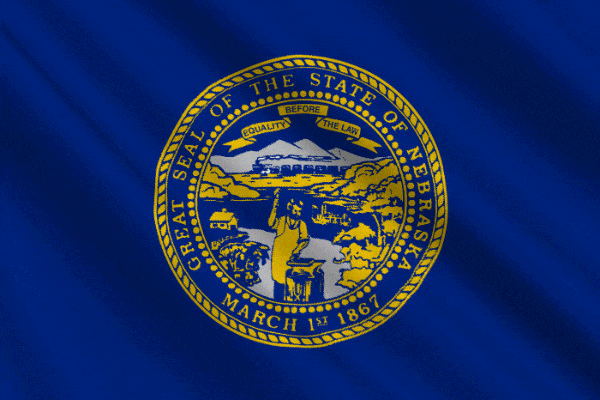Nebraska
State abbreviation/Postal code: Nebr./NE Governor: Pete Ricketts, R (to Jan. 2019) Lieut. Governor: Mike Foley, R (to Jan. 2019) Senators: Ben Sasse, R (to Jan. 2021); Debra Fischer, R (to Jan. 2019) Historical biographies of Congressional members Secy. of State: John Gale, R (to Jan. 2019) Atty. General: Doug Peterson, R (to Jan. 2019) Treasurer: Don Stenberg, R (to Jan. 2019) Organized as territory: May 30, 1854 Entered Union (rank): March 1, 1867 (37) Present constitution adopted: Oct. 12, 1875 (extensively amended 1919–20) Motto: Equality before the law
Nicknames: Cornhusker State (1945); Beef State Origin of name: From an Oto Indian word meaning “flat water” 10 largest cities (2012 est.): Omaha, 421,570; Lincoln, 265,404; Bellevue, 52,604; Grand Island, 49,989; Kearney, 31,790; Fremont, 26,167; Hastings, 25,058; North Platte, 24,592; Norfolk, 24,332; Columbus, 22,509 Land area: 77,358 sq mi (200,365 km2)) Geographic center: In Custer Co., 10 mi. NW of Broken Bow Number of counties: 93 Largest county by population and area: Douglas, 517,110 (2010); Cherry, 5,961 sq mi. State parks: 87 Residents: Nebraskan 2015 resident population est.: 1,896,190 2010 resident census population (rank): 1,826,341 (38). Male: 906,296 (49.6%); Female: 920,045 (50.4%). White: 1,572,838 (86.1%); Black: 82,885 (4.5%); American Indian: 18,427 (1.0%); Asian: 32,293 (1.8%); Other race: 79,109 (4.3%); Two or more races: 39,510 (2.2%); Hispanic/Latino: 167,405 (9.2%). 2010 percent population 18 and over: 74.9; 65 and over: 13.6; median age: 36.2. |
French fur traders first visited Nebraska in the late 1600s. Part of the Louisiana Purchase in 1803, eastern Nebraska was explored by Lewis and Clark in 1804–1806. A few years later, Robert Stuart pioneered the Oregon Trail across Nebraska in 1812–1813, and the first permanent white settlement was established at Bellevue in 1823.
Western Nebraska was acquired by treaty following the Mexican War in 1848. The Union Pacific began its transcontinental railroad at Omaha in 1865. In 1937, Nebraska became the only state in the Union to have a unicameral (one-house) legislature. Members are elected to it without party designation.
Nebraska is a leading grain-producer with bumper crops of sorghum, corn, and wheat. More varieties of grass, valuable for forage, grow in this state than in any other in the nation. The state's sizable cattle and hog industries make Dakota City and Lexington among the nation's largest meat-packing centers.
Manufacturing has become diversified: Firms making electronic components, auto accessories, pharmaceuticals, and mobile homes have joined such older industries as clothing, farm machinery, chemicals, and transportation equipment. Oil was discovered in 1939 and natural gas in 1949.
Among the principal attractions are Agate Fossil Beds, Homestead, and Scotts Bluff National Monuments; Chimney Rock National Historic Site; a recreated pioneer village at Minden; SAC Museum near Ashland; the Stuhr Museum of the Prairie Pioneer Grand Island; Boys Town; the Sheldon Memorial Art Gallery and the Lied Center for the Performing Arts at the University of Nebraska in Lincoln; the State Capitol in Lincoln; the Joslyn Art Museum in Omaha; the Henry Doorly Zoo in Omaha; Museum of Nebraska Art in Kearney; Museum of Nebraska History in Lincoln; and the University of Nebraska State Museum in Lincoln.
See more on Nebraska:
Encyclopedia: Nebraska
Encyclopedia: Geography
Encyclopedia: Economy
Encyclopedia: Government
Encyclopedia: History
Monthly Temperature Extremes
All U.S. States: Geography & Climate
Printable Outline Maps
Record Highest Temperatures
Record Lowest Temperatures
Highest, Lowest, and Mean Elevations
Land and Water Area
All U.S. States: Population & Economy
Historical Population Statistics, 1790–Present
Per Capita Personal Income
Minimum Wage Rates
State Taxes
Federal Government Expenditure
Percent of People in Poverty
Births and Birth Rates
Homeownership
Percentage of Uninsured by State
All U.S. States: Society & Culture:
Most Livable States
Healthiest States
Most Dangerous States
Smartest States
Crime Index
Residency Requirements for Voting
Compulsory School Attendance Laws
Driving Laws
National Public Radio Stations
Selected famous natives and residents:
- Grace Abbott social worker;
- Bess Streeter Aldrich author;
- Grover Cleveland Alexander baseball pitcher;
- Fred Astaire dancer and actor;
- Max Baer boxer;
- Bil Baird puppeteer;
- George Beadle geneticist;
- Marlon Brando actor;
- William Jennings Bryan political leader;
- Warren Buffett investor;
- Johnny Carson TV host;
- Willa Cather author;
- Dick Cavett TV entertainer;
- Richard B. Cheney vice president;
- Montgomery Clift actor;
- James Coburn actor;
- William “Buffalo Bill” Cody showman;
- Sandy Dennis actress;
- Mignon Eberhart author;
- Harold “Doc” Edgerton inventor;
- Ruth Etting singer and actress;
- Henry Fonda actor;
- Gerald Ford former president;
- Bob Gibson baseball player;
- Howard Hanson conductor;
- Leland Hayward producer;
- Robert Henri painter;
- David Janssen actor;
- Francis La Flesche ethnologist;
- Melvin Laird politician;
- Frank W. Leahy football coach;
- Harold Lloyd actor;
- Malcolm X civil rights advocate;
- Dorothy McGuire actress;
- Julius Sterling Morton politician and journalist;
- John G. Neihardt epic poet;
- Nick Nolte actor;
- George W. Norris senator;
- John J. Pershing army general;
- Nathan Roscoe Pound educator and botanist;
- Red Cloud Indian rights advocate;
- Mari Sandoz author;
- Standing Bear Indian rights advocate;
- Robert Taylor actor;
- Susette La Flesche Tibbles Omaha Indian activist;
- Paul Williams singer, composer, and actor;
- Julie Wilson singer and actress;
- Darryl F. Zanuck film producer.


